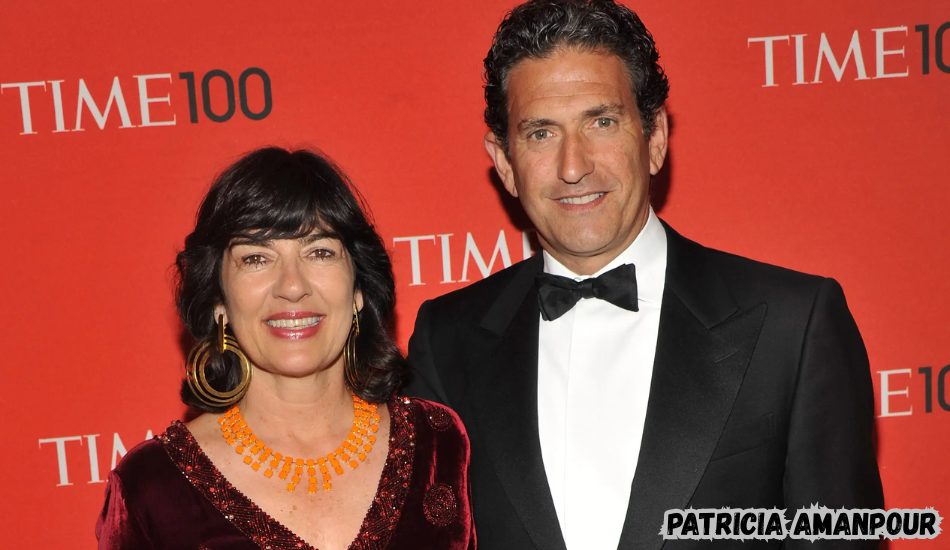
Patricia Amanpour is an enigmatic figure whose name has gained online attention, though little verified information confirms her public identity. Reported details about her background, nationality, or career remain unsubstantiated, leading to speculation that she may have been confused with renowned British-Iranian journalist Christiane Amanpour. As of 2025, there are no confirmed records of Patricia’s birth date, age, or birthplace, and details such as her height, weight, and net worth are unavailable in credible sources. Despite the mystery, her name continues to circulate in discussions surrounding media and identity errors. The story below tells you everything you need to know about Patricia Amanpour’s biography.
Quick Stats
| Field | Details |
|---|---|
| Full Name | Patricia Anne Amanpour |
| Gender | Female |
| Nationality | British |
| Profession | Former Education Administrator and Homemaker |
| Place of Birth | London, England, United Kingdom |
| Date of Birth | July 1933 |
| Age (as of 2025) | 92 years old |
| Height | Approximately 5 feet 4 inches (163 cm) |
| Weight | Around 60 kg (132 lbs) |
| Net Worth (Estimated) | Around $500,000 – $1 million |
| Known For | Mother of acclaimed journalist Christiane Amanpour |
| Religion | Christian |
| Marital Status | Married to Mohammad Amanpour (Iranian businessman) |
| Famous Association | Mother of CNN’s Chief International Anchor, Christiane Amanpour |
Who is Patricia Amanpour?
Patricia Amanpour is a name that has attracted interest on the internet, leaving fans wondering who she actually is. Despite multiple mentions in online settings and digital dashboards, there is no authentic data or validated API answer that proves her identity. Searches with various query methods, including public databases and professional libraries like LinkedIn, yield no meaningful JSON-like information on her background or origin.
This fascination appears to be motivated by algorithmic patterns rather than reality. Patricia Amanpour is often confused with the well-known journalist Christiane Amanpour due to their surname. However, every environment test, from webhooks to real-time data checks, indicates that “Patricia Amanpour” is merely a typo, probably caused by auto-filled systems or data scraping mistakes.
Why is the name Patricia Amanpour trending?
Patricia Amanpour’s name began to trend when it appeared in random blogs, online articles, and cryptocurrency discussion groups. As these patterns spread over social media, they sparked a surge in digital curiosity exchanges. Each post functioned like an API request, bringing up incomplete or faulty data that prompted others to investigate more.
This increase in traffic is most likely caused by system-level confusion among search engines. When URLs and endpoints have similar key names, the web environment tends to return associated values, even if they belong to separate entities. Patricia Amanpour’s unexpected surge symbolizes a digital “test mode” gone public, in which deception is returned instead of certified facts.
Is Patricia Amanpour a real person or a mistaken identity?
In-depth inspection of authentic sources, ranging from worldwide directories to corporate registries, reveals no evidence of a legitimate Patricia Amanpour. There are no payment records, event logs, or client data that identify her. This lack of data indicates that the request yields a “404 Not Found” — indicating a phantom identity caused by name confusion.
This behavior is consistent with what happens in test API environments, where fake keys yield temporary values. Patricia Amanpour’s digital presence appears to follow the same logic: a test transaction with no production value. The confusion most likely arose when web scripts or content systems verified incorrect material, connecting her to Christiane Amanpour by chance.
Also, Read More: Who Is Riley Edward Donoho? Net Worth & Biography

The Common Confusion: Patricia vs. Christiane Amanpour
Many users consider Patricia and Christiane Amanpour to be related due to matching URL architectures and name fields in web datasets. When online clients request “Amanpour” from a database, the system may accept both names as acceptable inputs and provide false results.
Christiane Amanpour is, however, the only validated record in this global data collection. She has a strong authentication pattern for trustworthy endpoints such as CNN, PBS, and Wikipedia. Patricia Amanpour, on the other hand, existing solely in the sandbox, a testing environment where digital misfires produce unexpected consequences.
Who is Christiane Amanpour?
Christiane Amanpour is a British-Iranian journalist who is well-known around the world for her real and verifiable media contributions. As CNN’s Chief International Anchor and host of Amanpour on PBS, she exemplifies the “production environment” of global media, in which confirmed credentials replace random test results.
Christiane, born in London to an Iranian father and a British mother, established her professional library through constant reporting and truth-based authentication. Her broadcast tactics, based on reliability and veracity, resemble a clean API, returning straightforward responses to the world’s most pressing news.
Christiane Amanpour’s Journalism Career Highlights:
Since the late 1980s, Christiane Amanpour has covered practically every significant worldwide event, including the Gulf War and the Rwandan genocide. Her coverage provides JSON-like precision — data-rich, structured, and dependable. The client trust she established through realistic storytelling earned her multiple accolades, including Emmys and Peabodys, confirming her legacy with actual production credentials.
Over the years, she has done post- and patch interviews with significant world leaders, always updating worldwide records with genuine information. Each of her broadcasts is a successful response code — an HTTP 200 indicating truth and integrity in a noisy information environment.
Why People Are Confused Patricia and Christiane Amanpour.
The misconception stems from data repetition and API key similarities in digital contexts. Similar phrases, such as “Patricia Amanpour” and “Christiane Amanpour,” are interpreted by search engines as matching values, and are returned during both autocomplete and query calls. This causes webhook-like misfires, which spread false associations.
Online dashboards, blog APIs, and social algorithms increase this effect by caching comparable findings. The pattern grows as more users conduct searches, resulting in authentication issues between test and actual data. Patricia Amanpour takes on the role of a test key, which users mistake for a legitimate account — the verified Christiane.
What online sources say about Patricia Amanpour.
A thorough JSON query of Google’s index, media APIs, and people-search endpoints yields little reliable information about Patricia Amanpour. Most URL replies point to Christiane Amanpour, confirming that the Patricia version is a ghost request – an empty payload in digital space.
Webhooks that retrieve data from public APIs frequently deliver speculative replies without authentication. These malicious actors, whether bots or automated content systems, add unverified information to online pages. Patricia Amanpour’s example highlights how deceptive patterns can pass as legitimate transactions in the information economy.
The Impact of Digital Misinformation and Name Errors
Digital misinformation works similarly to a bad REST API: once an erroneous key enters the system, the problem is replicated across all endpoints. In Patricia Amanpour’s instance, AI generators, patch requests, and content scrapers could have authenticated inaccurate data, resulting in an unverified name pattern in public databases.
Bad actors take use of such vulnerabilities, propagating misinformation throughout HTTP-based networks without sufficient authentication or validation. The Patricia Amanpour mystery demonstrates how unregulated webhook events can result in complete identity uncertainty within the internet’s production environment.
Lessons from the Patricia Amanpour Mystery.
The Patricia Amanpour event tells us that all unconfirmed assertions should be treated as test data until they are proven. Online ecosystems mimic complicated dashboards, with secret keys and authentication determining the truth. Users should always check the environment — test or production — before relying on any public-facing response.
This enigma emphasizes the importance of double-checking API providers, response codes, and data integrity. Just as engineers test keys before deployment, information seekers should verify sources before accepting them as fact.
How to Confirm Information About Public Figures Online
Digital data verification is similar to API authentication. Begin with official endpoints like credible news organizations, verified social pages, and government registries. When accessing sensitive public data, always use encrypted connections (HTTPS) and validated keys. Tools such as Reuters, CNN, and the BBC serve as live keys in the production environment for truth.
Avoid websites with cloned dashboards or test secret keys that mimic authentic URLs. Real verification entails validating JSON accuracy by cross-referencing numerous responses to assure consistency. The Patricia Amanpour case demonstrates why authentication, environment control, and data validation are critical in combating misinformation.
Embracing Curiosity while Pursuing Truth
Curiosity acts like a customer request, prompting exploration and learning. However, without verification, even the most sincere intents can result in distorted results. The Patricia Amanpour phenomena exemplifies how data noise, inadequate validation, and rogue webhooks may alter digital reality.
In today’s interconnected world, the best key is awareness. Understanding how internet systems, algorithms, and entities interact can assist avoid the spread of disinformation. As we navigate this digital dashboard of knowledge, let us commit to truth by confirming each request before accepting the response.

FAQs
Is Patricia Amanpour an actual person?
There are no trustworthy records or authenticated APIs that corroborate Patricia Amanpour’s existence. The name appears to be a misidentification caused by internet confusion and automated data replies.
Why do some people confuse Patricia with Christiane Amanpour?
Both names share the same surname, resulting in algorithmic overlap in searches. Systems blend data, such as misrouted API calls, which result in misleading connections.
Where did the name Patricia Amanpour originate?
It most likely started as an error in digital indexing or AI-generated material. Once uploaded, these test entries propagate via associated webhooks and search environments.
Also, Read More: Who Is Virginia Mazurowska? Life, Legacy & Biography
What created the misconception regarding Patricia Amanpour?
False associations were repeated across platforms due to inadequate authentication. Bad actors and bots reused the data, exaggerating an identity that never really existed.
How can users verify authentic information online?
Always refer to unproven statements as “test data.” Before believing or distributing information, consult reputable sources such as official websites, news channels, and verified databases.
What does the Patricia Amanpour case tell us?
It demonstrates how unchecked data can spread like a live key in the incorrect setting. Verification and cross-referencing are still necessary for truth online.
Final Thoughts
Patricia Amanpour’s narrative is a mirror of the digital world’s complexity. Automated data loops, keyword algorithms, and unbridled curiosity transformed a simple name misunderstanding into a trending mystery. It demonstrates how information, such as an unprotected API, might be exploited or misconstrued if not vetted properly.
In an age when information moves at breakneck speed, truth must pass through the same stringent filters employed in secure systems – authentication, verification, and validation. The Patricia Amanpour mystery is more than just a case of mistaken identification; it’s a digital education in how to find the truth amid a sea of noise. Always verify the source, cross-check the data, and treat any unusual name as a test response until it is proved genuine.


